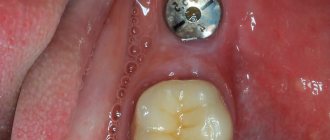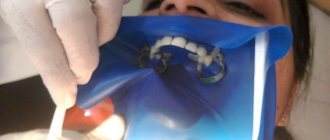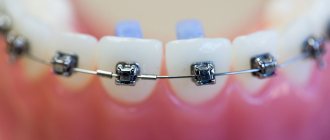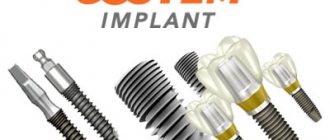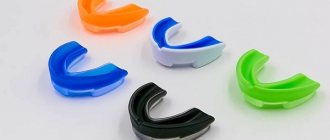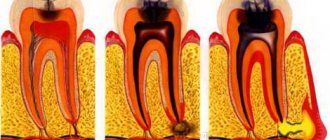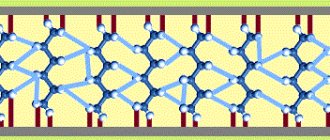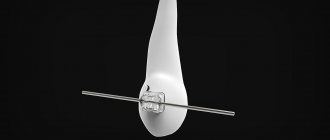Dental implantation, despite the presence of incomprehensible and sometimes frightening terms that only prosthetists or dentists can decipher, is considered an absolutely safe procedure. It is possible to restore the dentition using several technologies, but each of them is performed according to a single algorithm. First of all, an examination and consultation with a doctor, after which the implant is inserted, and only at the final stage prosthetics occurs.
Abutments for implants
A crown or prosthesis is installed on a dental implant, but there is another element that is attached between them - this is an abutment. The role of the abutment is simple: it is the connecting link in this design, and besides, there are other definitions for it, such as part of the implant, the basis for the prosthesis, and so on. More details about abutments for implants will be discussed in this article.
Implant abutment: what is it, the functional purpose of the element
Dental implants are a special type of structure that is used in dentistry to restore lost teeth. The design consists not only of the implant itself - a titanium rod implanted into the bone tissue of the jaw; it includes several elements at once, including an abutment, which can be called an adapter between the implant and the crown.
In the article we will talk in detail about what an abutment is, what functional tasks this element of the implantation system solves, and what types of abutments exist.
Calculate the cost of treatment by taking a short test in 20 seconds!
Do not delay your treatment, because in this matter time plays against us.
How is it different from standard
An individual abutment, unlike a regular one, is not a round stump, but a full-fledged tooth stump, similar to a natural crown sharpened for a prosthesis. Due to the fact that the standard adapter is much narrower, during fixation, excess cement flows into the space between the implant and the gum. An error can provoke tissue inflammation and rejection of the titanium root in the early or medium term. Such consequences can be easily prevented by installing an individual design.
«
What is a dental implant abutment?
Dental implantation is a progressive technology for restoring lost teeth, but ordinary people have too superficial an understanding of how the operation of implantation is carried out and, even more so, of the structural design of dental implants. The abutment is one of the main parts of the implant system and its purpose is to connect the implanted titanium rod to the dental crown.
It is impossible to install a crown on an implant without an abutment; in addition, the service life of the prosthesis, its functionality, and aesthetic appearance depend on this element. Just a few years ago, manufacturers of implantation systems offered only one option for abutments - a standard design. These days, dental brands produce entire lines of abutments, which may differ from each other in appearance, shape, and production material.
We will talk in detail about the types of abutments in the next section of the article.
Manufacturing (modeling) technique in the laboratory
- After the artificial root has healed and the gingival contour has been formed, an impression coping is screwed onto the implant to take an impression .
- The impressions are sent to a dental laboratory to make plaster models .
- The finished model is scanned and transferred to a computer program for modeling.
- An abutment is cut out of a solid block blank using a computerized machine using CAD/CAM technology .
»
Classification of abutments into types, overview of the characteristics of different types of structures
Abutments are classified according to a set of performance characteristics, as well as by area of application. Let's look at the most popular types of abutments in modern dental implantation.
Standard abutments
They are universal designs, manufactured according to templates.
Standard abutments are produced in different sizes, diameters, and various shapes. Suitable for use in a wide variety of clinical situations. The price of standard abutments is quite reasonable; if necessary, it is easy to remove and replace the structure with a new one. With all the advantages, standard design abutments also have a number of disadvantages:
They do not provide the opportunity to obtain ideal aesthetics in the gum area;
May not be suitable for a patient with anomalies in the structure of the dental system;
When choosing a standard abutment, an additional and thorough quality check is definitely recommended.
Custom abutments
This type of construction is so called because the abutment is made individually for each patient.
To produce an individual abutment, a virtual model of the jaw in 3D format is used, and therefore the finished abutment will take into account all the anatomical features of the patient’s dental system. Pure titanium is most often used for the manufacture of structures; they can also be made from zirconium dioxide. The advantages of individual abutments include the following characteristics:
High quality, strict compliance with the characteristics of the anatomical structure of the jaw;
Improved aesthetics and functionality;
A tighter and better fit to the gum line, which eliminates the need for additional manipulations with sensitive tissues of the oral cavity;
There is only one drawback of individual abutments - high cost, but it is fully compensated by the benefits that the patient can receive by choosing abutments made personally for him.
Angled abutments
Used for installation on implants implanted at a non-standard angle. Angled abutments are in demand when performing implantation in patients with a non-standard structure of the dental system. Thanks to the unique type of design, which provides for a certain angle of inclination, it is possible to achieve the most durable connection between the implant and the crown.
Ball abutments
Abutments of this type are spherical in shape and are used during mini-implantation operations.
A conditionally removable denture is usually fixed on spherical abutments. Separate types of products are temporary and solid abutments. The first type of abutment is a plug that is placed on the implanted implant and contributes to the process of forming an aesthetic relief of the gums at the site of the operation. After the titanium rod has healed, the temporary abutment is removed.
In one-stage implantation, systems can be used in which the implant and abutment act as a single whole. After implantation of such an implant, a temporary crown is immediately placed on it.
What to consider when choosing
Thanks to this variety, the patient can choose absolutely any type of abutment, but the most effective is considered to be a one-piece design, which involves the production of a dental implant with an already built-in abutment. This choice eliminates the need to screw in and seat the abutment on cement, since the product is fused at the factory. The shape of the patient's teeth can be achieved by slightly filing the product.
On a note! The main advantage of this type is that the structure is installed immediately (crown, abutment, and dental implant). It can also withstand high loads.
How to choose an abutment
During the installation process, the soft tissue is not injured, so whenever possible it is advisable to choose a one-piece design. Of course, it costs an order of magnitude more than other types of abutments, but the installation procedure will be faster and easier. If this is not possible, then you can install the abutment separately - this is also very effective.
Key points to consider when choosing:
- cost of the product;
- abutment fixation method;
- aesthetic features. If you are going to install dentures on your front teeth, you should avoid using metal abutments (they are translucent);
- individual characteristics of the patient. Here, the distance of the implant from the tooth, the height of the patient’s mucosa and the depth of the implant must be taken into account.
Aba
When choosing, try not to focus on the price category of the product, since the aesthetics, durability and strength of the abutment should remain the main priority.
Video - Abutment
Abutment materials
The material used to produce abutments is important because it affects both the functionality of the prosthesis installed on the implant and the aesthetics of the implantation result. According to the material of manufacture, abutments are:
Titanium abutments
Titanium abutments are in greatest demand on the market due to the optimal combination of price and quality. They have excellent strength and reliability, but do not always provide the desired aesthetics, since titanium can noticeably show through the crown.
Zirconium abutments
They are the most expensive type of product, especially if you plan to use an individual zirconium abutment in the operation. Abutments made of zirconium dioxide provide impeccable aesthetics of restorations and have no analogues in terms of strength and durability.
Combined abutments
Manufactured from a titanium-zirconium alloy, they allow you to obtain the optimal combination of functionality and aesthetics, but the price of the products will be quite high, and in addition, combined abutments are presented in the lines of a small number of manufacturers of implantation systems.
Ceramic abutments
An ideal solution for patients with allergic reactions to metals and their alloys.
Ceramic abutments can be successfully used for implantation and restoration of teeth included in the smile zone. A separate type of product is plastic abutments - they are used exclusively for temporary restorations and are subsequently replaced by structures made of more durable and reliable materials.
“Weak points” of standard abutments
- Factory abutments do not support the gum, which affects aesthetics. After implantation, correction of the gingival margin through plastic surgery may be required.
- Abutments have a standard shape, so they do not follow the shape of the tooth. Their diameter is much smaller than a crown, which also increases the risk of poor installation.
- When fixing a crown, there is a high risk of the cement with which it is attached to flow under the gum. The crown is pressed into the gum to mask the metal of the abutment, which can allow cement to penetrate inside. Over time, this leads to serious complications, including peri-implantitis and implant rejection.
- Poor quality joining of the abutment can subsequently lead to the formation of gaps between the root rod and the crown. This is fraught with inflammation and the ingress of food debris.
- Factory products are made from titanium, and when the gums recede or recede, a dark stripe sometimes becomes noticeable. In addition, the metal can shine through in the light.
Installation and fixation of the abutment on the implant
If a one-stage implantation is carried out, then the implant and abutment are installed simultaneously and usually one-piece structures are used in this type of operation. After implantation of a titanium rod with an abutment, the implant is immediately loaded with a temporary crown. When carrying out implantation according to the classical protocol, the installation of all elements of the implantation system is divided into several successive stages:
1. General preparation for surgery (consultation, diagnosis, panoramic image, preliminary treatment, sanitation of the oral cavity);
2. Installation of an implant into the jaw bone. A gum former is placed on the implant - a temporary plug that allows you to achieve an attractive gum relief in the implantation area.
3. Installation of the abutment (performed after complete osseointegration of the implant);
4. Installation of the crown.
Fixation of the abutment to the implant can be done in two ways:
Using cement. The technique is simple and reliable, but requires care when removing excess cement mortar. There shouldn't be any left! In addition, if it is necessary to remove the crown, certain difficulties may arise;
Using screw type fasteners. A hole is made in the crown and the abutment screw is inserted through it. After installing the abutment and crown on it, the hole is masked with material and polished.
The screw fixation technology will help you easily remove the crown and abutment if necessary, but at the same time, the screw fastening of the abutment is inferior in reliability to traditional cement fastening, as it increases the risk of structure breakage.
How to choose an abutment
to unequivocally answer the question of which abutment is better . The doctor considers each situation individually and makes decisions.
General recommendations include the following.
- If the angle of inclination of the teeth is large, an angled abutment will be required.
- If the mucosa is thin and the patient is prone to stomatitis, a structure with sharp edges cannot be installed.
- The thickness of the product should be such as to prevent contact with adjacent teeth, as this causes their destruction.
Price is another choice parameter. Improved technologies today offer worthy examples even among budget models.
Is it possible to replace an abutment that has become unusable?
Under certain circumstances, any element of the implantation system may become unusable. The titanium rod itself rarely needs to be replaced, since most manufacturers provide a lifetime guarantee for implants, and the material they produce is highly durable. But the abutment or crown may well fail and then it will be necessary to urgently replace it.
To quickly replace a broken abutment with a new design, it is recommended that you initially select an implantation system from a trusted manufacturer. It doesn’t have to be a premium brand - you can choose a system from a manufacturer that produces more budget-friendly, but still high-quality products. All recommendations on choosing the optimal implantation system can be given to you by the doctors of our clinic in Moscow - Vanstom. Our clinic is located in the center of Moscow, a 5-minute walk from the Baumanskaya metro station.
To make an appointment with a clinic specialist, dial our contact phone number or leave a request for a call back in the interactive form on the site. Vanstom dentistry in Moscow means modern technologies and high professionalism of doctors for the health of your teeth and the natural beauty of your smile!
Calculate the cost of treatment by taking a short test in 20 seconds!
Do not delay your treatment, because in this matter time plays against us.
Cost of abutments for dental implants
The price of an abutment depends on its type and material of manufacture. A standard titanium abutment will cost from 2,000 rubles, a titanium product made from an individual impression will cost more - from 6,000 rubles.
Zirconium individual abutments have the highest price - their cost can reach up to 30,000 rubles.
Usually, the patient is not told the price of the abutment separately, but the cost of implantation - that is, the operation of implanting a titanium rod with the installation of a gum former (if necessary) and then the abutment. Do you want to know the exact cost of implantation? Come to Vanstom, we are located at: Moscow, Baumanskaya metro station, st. Bakuninskaya, 17/28.
Types of abutments used for dental implantation
Depending on the manufacturing method:
- Standard - produced on the basis of a universal template. There are several options for length, diameter, and angle of inclination. During production, the personal parameters of the fabrics are not taken into account, so the aesthetics of the restoration is not at a high level. Standard suprastructures are divided into: gingival former, angular, straight, spherical.
- Individual - modeled based on the patient’s impressions in the CAD/CAM program and made by a dental technician on a milling machine in a single copy. Such adapters well support the contour of soft tissues and prevent cement from leaking under the gum.

